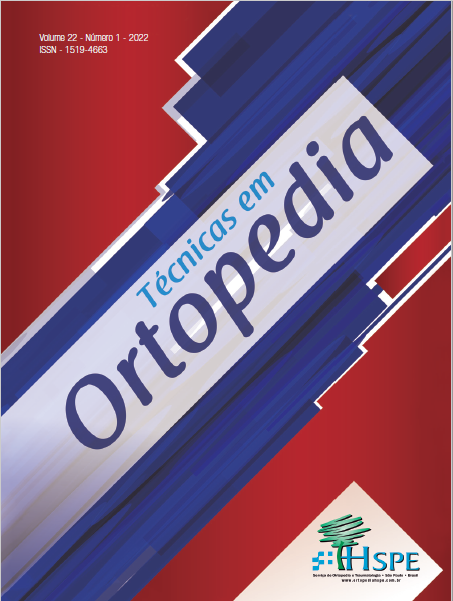Variante da via de acesso anterolateral para fraturas do planalto tibial com padrão posterolateral
Abstract
The surgical treatment of tibial plateau fracture aims to obtain
the best stability, alignment, early mobility, and pain elimination to
reduce the risks of osteoarthritis in the future. Therefore, correctly
understanding the fracture is of utmost importance for decisionmaking
about the fracture fixation strategy and the best access
route. Some authors proposed a revision of the original classification
of plateau fracture through tomography and three-dimensional
interpretation, adding an analysis of the axial plane in anterior and
posterior quadrants. In their study, the authors concluded that the
tibial plateau fractures with deviation of the posterolateral corner
of the tibial plateau present joint incongruity and instability mainly
with the knee in flexion, indicating the need for a different approach.
The objective of this case report was to describe a variant approach
to the anterolateral access route for better access to posterolateral
fractures.
Downloads
References
Pires RE, Giordano V, Kfuri M, Fogagnolo F, Waldolato G, Pimenta F, et al. A complexidade do quadrante póstero-lateral nas fraturas do planalto tibial: relato de um caso atípico e revisão da literatura. Relatos Casos Cir. 2020;(4):e2844.
Kfuri M, Schatzker J. Revisiting the Schatzker classification of tibial plateau fractures. Injury. 2018;49(12):2252-63.
De Boeck H, Opdecam P. Posteromedial tibial plateau fractures: operative treatment by posterior approach. Clin Orthop Relat Res. 1995;(320):125-8.
Abbott LC, Carpenter WF. Surgical approaches to the knee joint. J Bone Joint Surg Am 1945;(27):277-310.
Faustino CAC, Góes CEG, Godoy FAC, Nishi ST, Bicudo LAR. A importância da ressonância magnética pré-operatória nas fraturas do planalto tibial. Rev Bras Ortop. 2011;46(Suppl 1):13-7.
Yao P, Gong M, Shan L, Wang D, He Y, Wang H, et al. Tibial plateau fractures: three dimensional fracture mapping and morphologic measurements. Int Orthop. 2022;46(9):2153-63.
Fernandez D.L. Anterior approach to the knee with osteotomy of the tibial tubercle for bicondylar tibial fractures. J Bone Joint Surg Am.1988;70(2):208-19.
Chen HW, Zhou SH, Liu GD, Zhao X, Pan J, Ou S, et al. An extended anterolateral approach for posterolateral tibial plateau fractures. Knee Surg Sports Traumatol Arthrosc. 2015;23(12):3750-5.
Cho JW, Kim J, Cho WT, Kim JK, Samal P, Gujjar PH, et al. Approaches and fixation of the posterolateral fracture fragment in tibial plateau fractures: a review with an emphasis on rim plating via modified anterolateral approach. Int Orthop. 2017;41(9):1887-97.
Marsh J, Smith ST, Do TT. External fixation and limited internal fixation for complex fractures of the tibial plateau. J Bone Joint Surg Am.1995;77(5):661-73.





